
Dragon Quest Monsters: The Dark Prince Review
I’ve got a confession to make. I think Dragon Quest IV might be not only one of my favorite games in the series, but possibly one of my favorite retro RPGs ever. Dragon Quest III is a wildly influential game for the future of the genre, but I think IV is special in the way it established the series’ unique way of storytelling. The way it introduces its party mechanics by having you play out the stories of your party members, and then only allows you to play as the hero in the final chapter to collect them across the world? Beyond ahead of its time for an NES game. I adore Dragon Quest IV, especially if you play it with the party chat features only available officially on the mobile port. I highly encourage you to give it a shot; it's a top-three contender for me.
So when the Dragon Quest Monsters series announced a comeback after six years of being dormant, specifically taking place in the world of Dragon Quest IV, I was beyond excited. A new turn-based Dragon Quest RPG! We haven’t gotten one of those since 2017! For those who had grown up with the series on the original Game Boy, this was also a big deal because the Japanese release didn’t have our subtitle “The Dark Prince”, it was just called Dragon Quest Monsters 3. It became my most anticipated game of 2023, because I’d take any excuse I could get to spend more time in one of my new favorite game worlds. However, I have no direct experience with the Monsters subseries. I like Pokemon well enough, and I have taken a quick gander at the Joker games, but after my teenage years, I haven’t found myself returning to the monster-raising genre well.
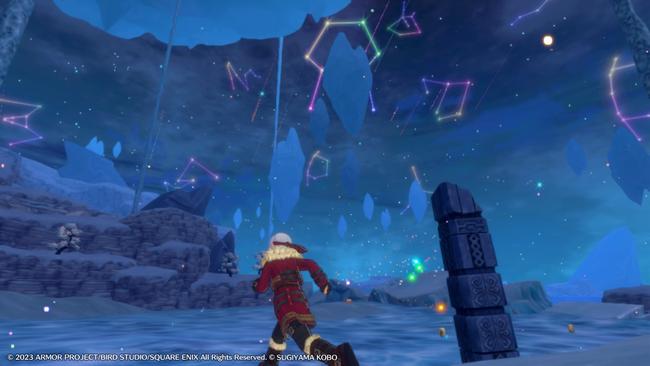
The Dark Prince is a strange game that feels like it is being pulled in several directions at once. But perhaps I’m the strange one for showing up more for the promised expansion of the story I cared about so much instead of the monster-collecting gameplay. However I must say, while the story might not have lived up to my expectations, I did fall madly in love with the same gameplay I didn’t even expect to enjoy. I thought the monster collecting would be a means to an end, but instead I got a wonderful RPG, with a merely serviceable narrative.
The plot follows Psaro, one of the main antagonists from IV in an alternate take on that story. You can expect it to follow the general timeline of IV, with some new scenes sprinkled throughout and some larger deviations later on. By the final act, The Dark Prince detours into a new wholly original plot, but it reaches this destination in an admittedly bizarre fashion. The setup is charming, simple, and to the point. Psaro is part human and part monster, his father being the king of all Nadiria, the Demon Realm of the Zenithian trilogy. As a child, his mother died of sickness, humans chased him out of his home, and his father cursed him to never be able to harm a monster directly. He grows up after that in a hidden little town, until he decides to go out and build a monster army to take revenge on his father and humankind. The setup for this game is absolutely fantastic, and I was hooked.
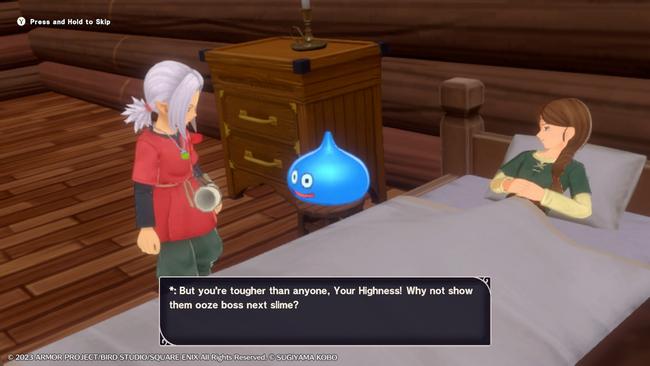
The gameplay of a Monsters game is pretty straightforward. Pokemon is one of the most popular games on the planet, and you have undoubtedly told a Pikachu to use Thunder Shock against another creature at some point in your life. There are a couple of quirks to Dragon Quest’s take on this genre that add enough complexity to stand on its own while keeping the baseline simplicity a Dragon Quest game needs to have to be approachable by anyone. There are 500 monsters to collect in The Dark Prince, and you can either scout them on the field or synthesize new ones based on previously recruited monsters. Or, you can find eggs out in areas to get a random monster, sometimes even with special stat growths.
Recruiting monsters is done with a scouting system that uses your active party’s stats to build up a percentage. The game rolls the dice on that percentage, and if you win, the monster joins you. You can influence this with food you give to monsters, and this will even increase the odds that a monster will ask to join you on their own volition after beating it in battle. When you first enter a new area in the game, your scout rate is a bit low, admittedly maybe a bit too low, but as soon as you beat the local Echelon boss, your scout rate will increase for that area. It’s effective at trying to balance the game and keep advancing through the story.
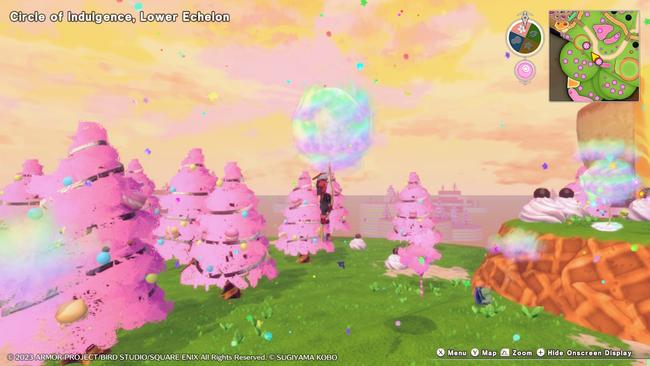
Battles play out fast and fun, especially if you’ve built your team right. Because there’s no skill limit, your monsters know every skill in their assigned Talents. Each monster has categories of Talents (a max of two if you collect them in the field, three if you synthesize) that you can put points into to unlock skills. How you allocate placing points into Monster’s Talents is entirely up to you, and there is a large variety of magic spells, passive buffs, or skills. When monsters hit a certain level they even unlock Traits in a list of tiers, giving them permanent buffs in battle. I swear I had one on my favorite slime that let him attack multiple times per turn. Monsters even have equipment you can buy or find in the field to further improve your monster’s stats. There are just so many different ways to build out your team, and the game will just lay it all out in the open with a menu UI that is solid to navigate.
There’s an auto-battle option at the top of your list of actions, encouraging players to let the combat play out itself. You can issue direct commands to your monsters in any place that isn’t the Monster Arena, but I honestly let myself more often than not let my monsters make their own decisions. The AI for both your team and enemies is well-designed, and I never felt like they were incompetent. You can even assign certain behaviors to specific monsters, and this will carry over between battles. Have a monster you only ever want to heal? I had given the game a full month break at one point, and then logged back in to discover my Heal Slime’s behavior was still set to healing. I appreciated that. You can even go one step further and program the likelihood moves play in the auto system. It might seem like this is the game saying to not engage with it, but I think it’s an admission that Dragon Quest Monsters is at its best when you’re constructing your party and coordinating your monsters. That’s why the Monster Arena exists, to check the player’s team and challenge them to go out there and discover more monster combinations.

I love how monster stats in The Dark Prince’s develop and grow across monster lineages. At your home base of Rosehill Tower, you can buy items, travel to new worlds, battle online, and go to the lower floor to visit the Altar of Amalgamation and fuse monsters together. Synthesis isn’t as complicated as something you’d see in Shin Megami Tensei, as you can only fuse two monsters together (as long as they’re level 10), but the way skills and stats carry over between monsters means I found myself in here far more often than I went to the Velvet Room or Cathedral of Shadows. I like those games typically because monsters boil down to their skills, and fusing upwards gets you better and better skills. This is true of this game, too, but if you max out a Talent tree upon fusion it will evolve into the next level of it. Your next monster will also gain altered or improved stat growths, so you’re encouraged to level up your monsters adequately if you want their synthesized offspring to be even better. I think The Dark Prince unlocked something in my brain and it basically led to 10 hours (this is a conservative estimate, I’m sure it was much more) of pure grinding.
I typically hate grinding, as a concept, and Dragon Quest isn’t typically a series that encourages it. But when the context of that grinding is building up stronger and stronger monsters, it becomes wildly exciting. I would reach a new area and instantly grab every new monster I’d find, run back to Rosehill, and then fuse up until I had new and better numbers. Since Monsters are all given ranks, sometimes this would lead me to getting a monster or two a rank higher than the game expected me to and it would be a lot of fun to steamroll certain parts my friends told me were hard. I didn’t do this intentionally to destroy the difficulty, and late-game bosses still offer entertaining difficulty spikes even while doing this, but the underlying systems laid themselves bare and I was enraptured by their siren call. I kept fusing and battling until I had an amazingly powerful team that could handle anything, and I then kept doing it throughout.
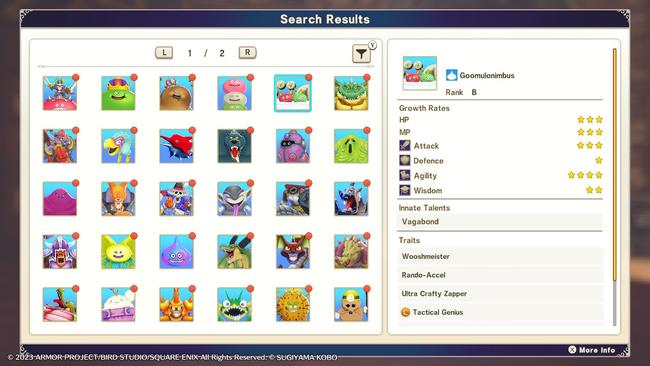
The Dark Prince’s gameplay is simple on the surface, but dive down and you’ll see a shocking amount of complicated depth to uncover. This is the most thought I’ve ever put into party composition in one of these RPGs, and has made me look at this genre differently. With a total of eight party slots, with four of those being active as well as the ability to switch your party in and out freely at the beginning of every turn for no cost. This is a cute Dragon Quest IV reference, and one of the major ways that game influenced the mechanics of a Monsters title.
I think my favorite aspect of The Dark Prince has to be the variety of locales. I was initially looking forward to exploring key locations from IV, but each area you visit in this game is wholly unique since you’re mainly exploring Nadiria. There are five main circles of Nadiria, and each of these is broken into three Echelons. You tackle these in arcs where you clear each of the circles of that echelon before moving to the next. The order in which you play the circles is often left at your own pace, displaying monster levels guiding you with a loose recommendation. I was surprised to see that Echelons are unique from each other, only connected (and sometimes loosely so) by the theme of the circle. The maps are sizable too, with a lot of fun platforming and side paths to explore. I’d have to say my favorite Circle was Caprice (gorgeous aesthetic, and it plays my favorite DQIV song, so go figure), and my least favorite was Temper (bland lava-themed map).
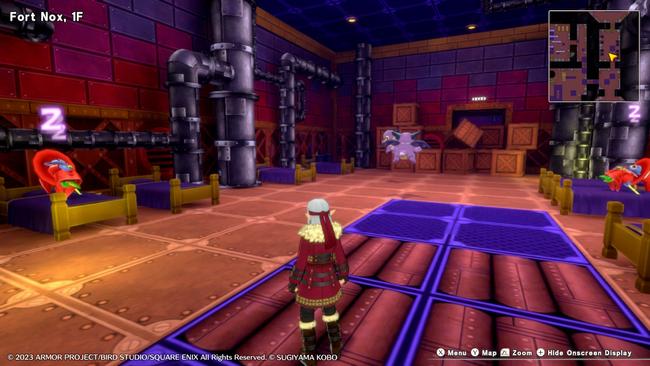
The layout of each map is very well designed, and a nice flex for the team finally making a Monsters game on a modern home console. Each one will typically have a dungeon at the end of each, and I’m thrilled to say they’re amazing. None ever overstay their welcome, and the longer ones feature engaging full-stage puzzles for you to piece together as you work your way through. None of them waste time, they’re visually interesting, there are interesting monster battles throughout, and I was always looking forward to finishing every chapter just to play through each Echelon’s dungeon.
Dark Prince’s main gimmick is a season system, accompanied by a unique weather mechanic for each echelon. Both of these affect traversal and the monsters that spawn in maps. For example, in one of the Echelons of the Circle of Indulgence, rivers of honey divide each of the main sections of the map. You’ll typically have to go the long way around to see all of them, but if Winter comes around these rivers will freeze, letting you just run across freely and bridging the gaps. Sometimes a season change will dry out a lake for you to explore, or maybe trigger a volcano to set off geysers to get to higher up places. There's even a slime rain weather where Bubble Slimes will spawn more frequently. I loved how creative they got with these.
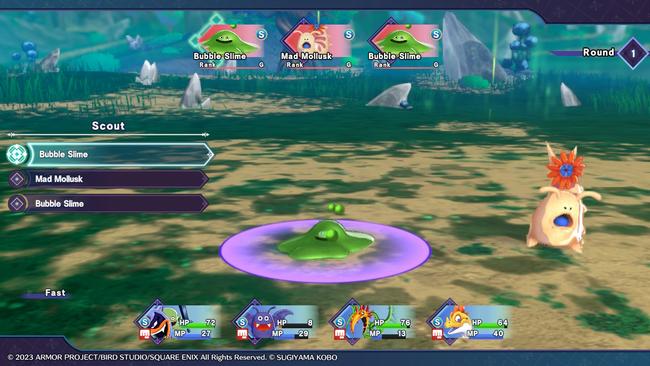
This mechanic essentially turns every map into about four, and gives completionists a lot to see and do. It adds another layer to hunting down chests and mini medals. I like this a lot, and western fans are likely to see this as a big step forward, but as someone who has played the Japanese-only Dragon Quest Monsters Joker 3 on 3DS, I miss monster riding. The platforming was a lot more interesting there because it encouraged party building in clever ways that didn’t just have to do with combat. In Joker 3, each monster had a unique traversal ability, and it allowed the designers to build out big maps. I don’t think this is a massive downgrade, but it would have been nice to see a blend of both ideas.
There was an earlier version of this review that bemoaned the visuals and performance, because if you followed this game at all from the beginning, the first thing you likely heard about was the frankly unacceptable performance this game launched with. I finished my entire initial playthrough with the game having a wildly inconsistent framerate, seemingly anywhere between 10 to 30 FPS depending on the area and visual effects going on. Around late December this problem was addressed almost entirely, leading to a much more consistent 30 FPS experience. There are still dips on occasion, but the game runs drastically better than it did originally. I don’t recall any outdoor area being able to ever hit 30 FPS on launch, and now it’s rare for it to not. I can’t quantify this, but it also seems like the visuals have improved somewhat. I wouldn’t say the resolution is that crisp, it is the Switch after all, but this game is an easy recommendation in its current state. It almost hurts my eyes after getting used to 45 hours of one of the Switch’s choppiest games.
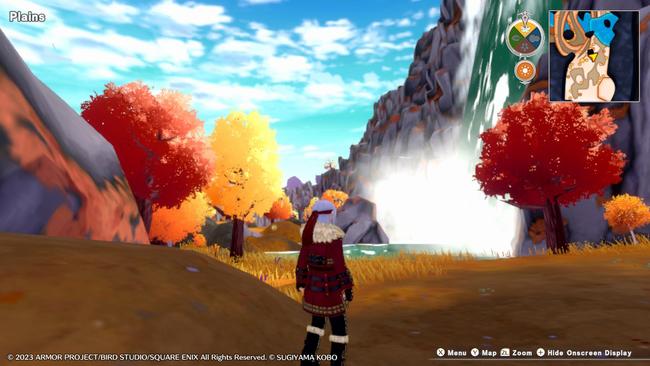
The latest patch also did wonders for my enjoyment of the game, smoothing out the experience a lot and adjusting rates or numbers for most of the systems. Originally you couldn’t Zoom directly to the Altar of Amalgamation and would have to go to the entrance and then jump directly down the stairs and to the basement. Eggs now respawn in maps more often and are even far fewer crashes. The game should have arguably launched like this, but I’m glad they were addressed. Companies typically leave Switch games like this to languish in imperfections, but time and effort were put into The Dark Prince to iron out an initially flimsy package. I’d be curious to see how this could look on PC, but until the day that gets announced, we are left only wondering.
Most of my criticisms of The Dark Prince have to do with the story. There are parts I loved, and that was mainly everything that wasn’t just trying to awkwardly retell Dragon Quest IV. At its best, I felt the story was reminiscent of a Chaos playthrough of an SMT game, since Psaro serves as more of an antihero than a traditional hero. He starts at the bottom, and you feel like you earn each step towards your goal of being the king of all monsterkind by building out your team. If you’re not a Dragon Quest fan, this won’t mean anything, but that’s a pretty big deal for this series. Our protagonist is actively trying to raise a monster army to exterminate the human race, all the while his well-meaning friends are trying to steer him in a better direction. On the way, he’ll help various monsters in episodic arcs across the Echelons and uncover an overarching conspiracy in Nadiria. Dealing with his rage is a concurrent theme and the game takes some interesting twists and turns while it develops. I especially loved the inclusion of Rose, Psaro’s love interest from IV. While she’s undoubtedly a better character in this game thanks to having adequate screen time and modern writing, I do wish they had tried to keep in the romantic aspects of their old relationship.
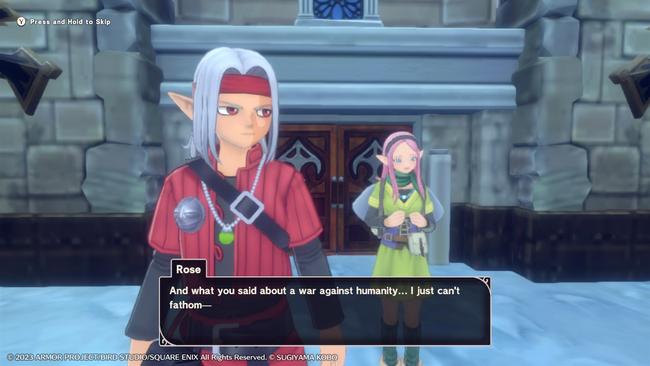
By the time I beat the final boss, I’m left wondering why Dragon Quest IV was chosen for a Monsters title. Make no mistake, I understand why fanservice exists. I am a fan, I like being serviced. The additions to the lore of Nadiria are interesting and lead to really amazing boss fights, so the gameplay reasons for picking IV were strong. Maybe they just knew that since I just can’t see a reason for adapting IV in the way they did, where Psaro is just awkwardly dragged around to key moments in IV. If you have not played IV, the game does very little to fill players in. While it would have been tedious to stick closely to IV, that game has never received any sort of 3D remake. It has no modern port outside of the mobile one, which is based on a DS version (which is based on a PS1 remake).
This was a great opportunity to introduce Dragon Quest IV to a new generation and give the story a modern spin. I’m sure that was the plan, but that isn’t what we got. If you have no knowledge of Dragon Quest IV, I think you’re likely to just be confused about what is happening. The Dark Prince teases fun moments with The Chosen (the party from Dragon Quest IV) but they’re barely introduced. They also barely show up in the game. There’s a specific iconic moment of tragedy I was beyond excited to see adapted from this story’s new perspective but the game speed runs through it in an unsatisfying way. If you are a fan of Dragon Quest IV you’re likely to find the rare moments calling back to that game awkwardly implemented. They’ll wonder why Solo, who is now explicitly being set up as a foil to Psaro, is just there and gone with no proper closure. I had hoped the post-game would explore this more, and it initially seems like it will, but it ultimately goes nowhere. The post game in general is short and a bit underwhelming, which is in stark contrast to how amazing and in-depth IV’s was in its DS remake. If you have a good team, you could probably knock it out in an hour or two. Maybe it seems like I’m putting too much value in the story, but The Dark Prince has the highest volume of cutscenes in the Monsters subseries. It’s clear they were trying to make the story a bigger deal in this one, so I set my expectations to match the experience they hinted at.
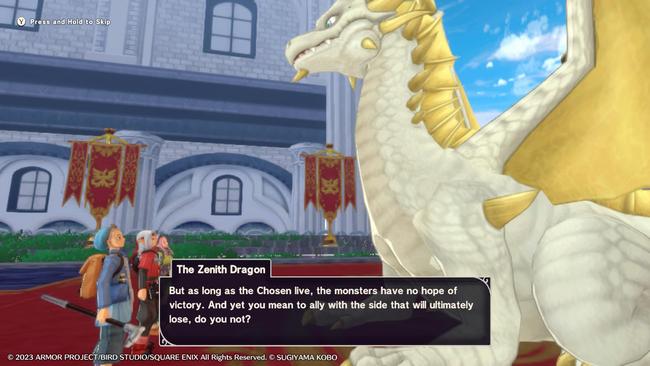
Dragon Quest Monsters: The Dark Prince is without a doubt a wonderfully made monster-collecting RPG. It takes the series known for being small handheld experiences and gives it the scope of a proper console game. I wouldn’t say it’s got AAA scale, and you shouldn’t expect something as massive as Dragon Quest XI. It has the weight of a proper console RPG though, and a meaty campaign with over 500 monsters to collect and train. I adored the gameplay, grinding it out for hours on end. After 45 hours and a cleared main story I still don’t feel like I’ve gathered all the monsters that I’ve could, even if the actual post-game is a bit of a letdown. As the latest in the Dragon Quest Monsters series, The Dark Prince is a strong offering. As a love letter to Dragon Quest IV, it’s lacking. I think that game has a legacy worth upholding, while there are certainly worse ways to uphold that I’m left wanting more.
I’ve had to sit on this game for quite a while to get my thoughts sorted. I wish the story wasn’t in such an awkward spot, because I think it has some fascinating ideas for the Dragon Quest series. From what I’ve gathered from fans of this series, maybe my frustrations with the storytelling make me an outlier. But it’s hard to find myself caring about the story when the game here is so fun. I adore the exploration, dungeon crawling, and battle mechanics featured here.
As a Dragon Quest fan, The Dark Prince feels like the first real RPG this franchise has seen since XI, and it has me hooked on this subseries. With this game officially being the third mainline entry in this series, what we got is nothing less than a triumphant return for this brand of monster-collecting RPGs. While the simplicity of the budget portable RPGs that preceded it lays dormant in Dark Prince’s DNA, this is a big step forward for the series.I had so much fun I grew to want more than what we got. I craved more to do by the end, and I wonder if that slight emptiness I feel with aspects of the game is a result of aspects being held back to make a Professional version down the road. Maybe that version could fix my qualms, or maybe being stuck on hypotheticals is pointless.